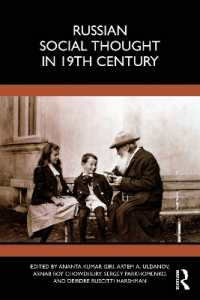- ホーム
- > 洋書
- > 英文書
- > Science / Mathematics
Full Description
This book is designed to help those with little or no background in the field of defect chemistry to apply its principles and to interpret the related behaviour of materials. It is the product of a course for advanced undergraduates and graduate students that the author taught at Lehigh University for over twenty years. The course is highly interdisciplinary and has been attended by students from the departments of chemical engineering, chemistry, electrical engineering, computer science, geology, materials science and engineering, and physics. The book is intended for use either as a text on such a course, or as a reference work that covers the major principles of defect chemistry.
Contents
1. Introduction
Reference
2. A Few Useful Crystal Structures
Introduction
Close-Packed Structures
Structures for Eight-Coordinate Cations
Structures for Ternary Compounds
Conclusion
References
Problems
3. Lattice Defects and the Law of Mass Action
Introduction
Lattice Defects as Part of the Equilibrium State
The Law of Mass Action
Another View of Mass Action
Lattice Disorder in Elemental Solids
Summary
References
4. Intrinsic Ionic Disorder
Lattice Defects and Reference States
Conservation Rules
Defect Notation
Major Types of Intrinsic Ionic Disorder
General Comments on Intrinsic Ionic Disorder
References
Problems
5. Extrinsic Ionic Disorder
Introduction
The AgCl-CdCl[2 System
The CaF[2-CaO System
The TiO[2-Nb[2O[5 System
Summary of Important Points
Schematic Representation of Defect Concetrations
Summary of Extrinsic Ionic Disorder
References
Problems
6. Defect Complexes and Associates
Introduction
Complexes Containing an Impurity Center and an Ionic Defect
Intrinsic Ionic Defect Associates
The Effect of Impurities on the Concentrations of Defect Complexes and Associates
References
7. Ionic Transport
Introduction
Basic Concepts of Diffusion
Ionic Conduction in Crystalline Solids
Intrinsic and Extrinsic Ionic Conduction
Fast Ion Conductors
References
8. Intrinsic Electronic Disorder
Introduction
The Development of Energy Bonds
The Mass-Action Approach
The Fermi Function
Holes, Waves, and Effective Masses
Electronic Conductivity
Hopping Mechanisms
The Band Structure of Compounds
Chemistry and the Band Gap
Summary
References
9. Extrinsic Electronic Disorder
Introduction
Interactions with the Gaseous Ambient
The Choice of Compensating Defect
The Chemical Consequences of Electronic Compensation
The Interactions of Impurity Centers with Electrons and Holes
The Situation for Compounds
Summary
References
10. Intrinsic Nonstoichiometry
Introduction
Nonstoichiometry in Pure Crystalline Compounds
Nonstoichiometry and Equilibrium Defect Concentrations
The Hypothetical Compund MX with Schottky Disorder
Summary of the Kröger-Vink Diagram for MX
Conclusion of the Discussion of MX
A More Complex Kröger-Vink Diagram
Summary of the Kröger-Vink Diagrams for Intrinsic Nonstoichiometry
Enthalpy Relationships
Conclusion
Reference
Problems
11. Extrinsic Nonstoichiometry
Introduction
A Simple Example: Donor-Doped MX
Enthalpy Relationships
A More Complex Example: Acceptor-Doped M[2O[3
General Considerations
Nonstoichiometric Reactions in the Impurity-Controlled Region
Problems
12. Titanium Dioxide
Introduction
The Amount of Nonstoichiometry
The Equilibrium Electrical Conductivity of Undoped TiO[2
The Seebeck Coefficient of Undoped TiO[2
Ionic Conduction in TiO[2
The Effect of Dopants on TiO[2
General Comments on the Defect Chemistry of TiO[2
References
Problems
13. Cobalt Oxide and Nickel Oxide
Introduction
Cobaltous Oxide, CoO
Nickelous Oxide, NiO
Summary
References
14. Barium Titanate
Introduction
General Expectations
The Equilibrium Conductivity of Undoped BaTiO[3
Insulating Properties of BaTiO[3
Acceptor-Doped BaTiO[3
Ionic Conduction in BaTiO[3
Donor-Doped BaTiO[3
Trivalent Dopants in BaTiO[3
Summary
References
15. Order versus Disorder
Block Structures
Summary
References
Index







